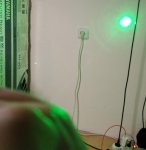Thought it would go in all directions equally.
If you imagine the particles as big, shiny spheres, you will expect a fairly even distribution of stray light in any direction. However, the world usually does not provide us with perfectly shiny and spherical dust grains and light travels more complicated than straight lines, when interacting with matter.
Gracing a dust grain, the wave nature of light makes it bend a little around the grain. The new path is a little off to the side of the grain, but still forward. It does not swing around shining backwards. This diffraction light can be seen from the front (looking towadrs the Laser) but not from the back (looking into the pointing direction). In addition, even quite dark (or transparent) particles are reflective when hit at a very shallow angle, deflecting more light off the path in forward direction, just a small angle. Reflecting backwards needs a center hit on the particle and a shiny surface. You still get a chance that the ray simply gets absorbed by the material. To get the light perpendicular of to the side, the surface of the grain must be hit at a precise angle, where the chances are comparably bad.
Putting this all together you will get the most stray light a few degrees off the nominal direction, followed by backward reflections. The chance to see a particle frm the side diminishes rapidly with growing angle.
All that said, the exact scatter profile depends heavily on the actual shape pf the particles, so this can be used to determine the shape from measuring the scatter profile. An interesting task when at times the air is full of pollen or ice crystals that produce all kinds of different halo.







